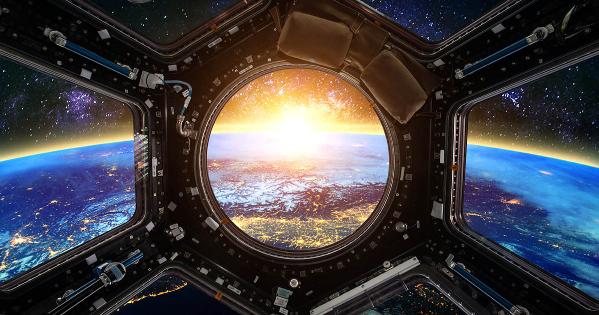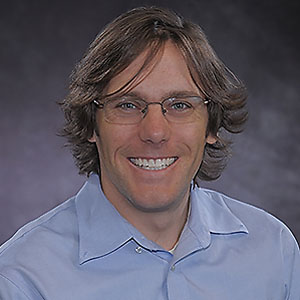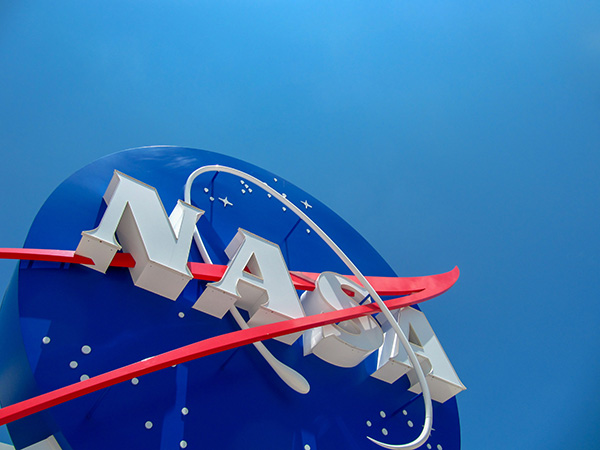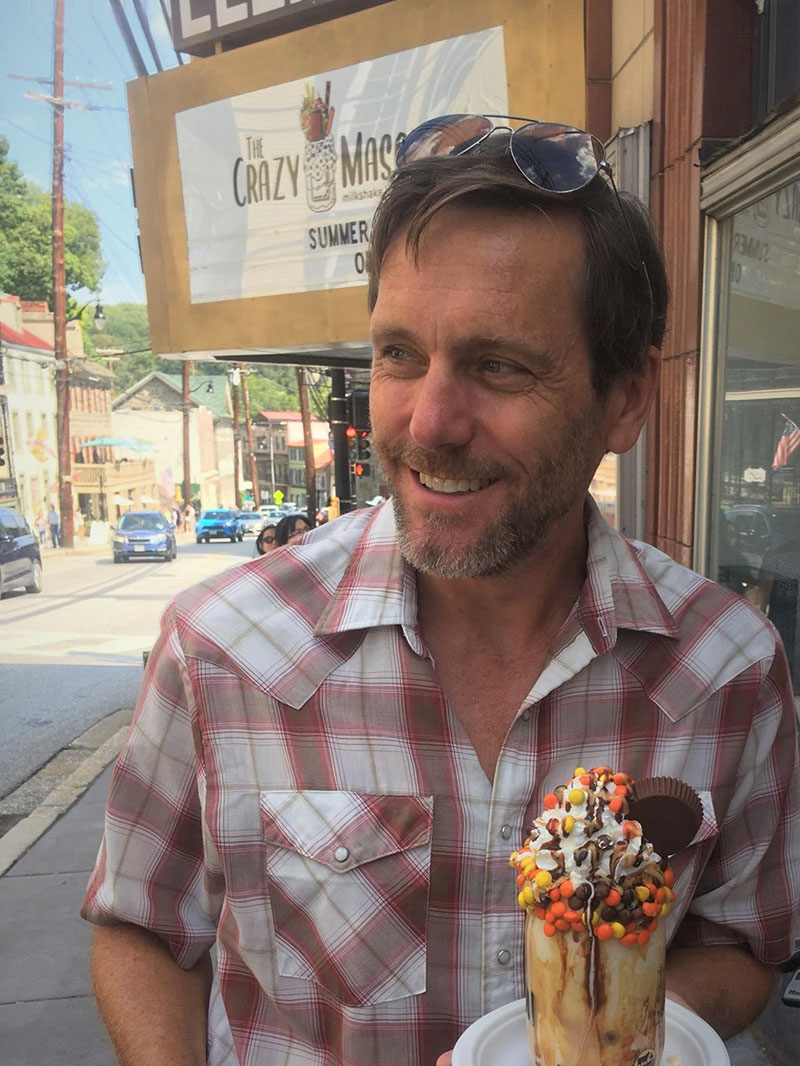From the Subatomic to the Cosmological: AU’s Professor Nathan Harshman

Department of Physics Professor and Chair Nathan Harshman pursues research in theoretical physics, focusing on the intersection of quantum information theory and particle physics. AT American University, he teaches across the physics curriculum, from introductory courses to independent studies on advanced topics. He is also the Director of the DC Space Grant Consortium, a NASA-funded initiative that offers undergraduate and graduate fellowships, scholarships and internships that put students at the forefront of scientific and engineering research and discovery.
We asked Professor Harshman to share some of his thoughts on quantum physics, the DC Space Grant Consortium, the “whimsy” of physics, and more.
Q. Tell us what you find most exciting about physics.
 A. That’s a big question, but one thing I love is that physics studies structures and dynamics at every scale from the subatomic to the cosmological. The principles and methods we apply to understand these different scales of space and time can be quite different, but what unifies them is what Nobel-laureate physicist Eugene Wigner called the “unreasonable effectiveness of mathematics.” I am a mathematical physicist who studies the symmetry of natural laws, and symmetry provides insight into every scale of the universe.
A. That’s a big question, but one thing I love is that physics studies structures and dynamics at every scale from the subatomic to the cosmological. The principles and methods we apply to understand these different scales of space and time can be quite different, but what unifies them is what Nobel-laureate physicist Eugene Wigner called the “unreasonable effectiveness of mathematics.” I am a mathematical physicist who studies the symmetry of natural laws, and symmetry provides insight into every scale of the universe.
Q. You’re the head of the DC Space Grant Consortium, a NASA-funded program that expands opportunities in DC to “discover, explore, experience, and be involved in science, technology, engineering, and mathematics.” Tell us about the consortium! What are some of the projects, grants, and success stories?
A. NASA sponsors a Space Grant Consortium based at a university in all 50 states, Puerto Rico, and Washington, DC. American University is the lead institution for DC, and all other higher education institutions in Washington are part of our consortium.
Our biggest project is to connect AU and our affiliates to NASA through internships at NASA Centers and by funding faculty-student research collaborations that support NASA missions. For example, at AU every summer we give at least ten STEM student awards to participate in faculty-mentored research projects. In another portfolio of projects, we work with DC Public Schools to bring NASA expertise and curriculum into K-12 STEM classrooms. Each summer DCPS (DC Public Schools) teachers learn about hands-on space science, comets and astrobiology, data science for environmental analysis…and we even sent some to a flight academy!
Q. One of the Consortium’s goals is to increase the strength and diversity of the future scientific and engineering workforce for the good of NASA and the entire nation. How are you working to do this? Can you share any success stories?
 Credit: Luis Martinez Merlos/Wirestock - stock.adobe.com
Credit: Luis Martinez Merlos/Wirestock - stock.adobe.com
A. Building a diverse future NASA and aerospace workforce is a central priority and informs everything we do, including how we structure programs, from advertisement and application to assessment and evaluation. One of our current programs is building a network of DC Space Grant Student Ambassadors to help us communicate to students at all our affiliates in their “digital native” language and provide us feedback on how to connect their home departments to NASA and DC Space Grant opportunities.
Students who we have supported in the past have gone on to amazing careers at NASA, in academia, and in industry. One of our AU Space Grant alums, Dr. Lauren Goodwin, applies her expertise in systems engineering and artificial intelligence as Chief Information Officer of NASA Johnson Space Flight Center and still finds time to recruit and inspire young women to join STEM fields.
Q. In addition to directing space grant, you also do research in theoretical quantum physics. I see you just recently gave an invited talk at the Max Planck Institute for the Physics of Complex Systems in Dresden, Germany. What was that about?
A. The conference was a meeting of theoretical and experimental quantum scientists discussing a promising new approach to engineering the next generation of quantum technologies. The systems we were talking about are so cold or so small (or both) that the rules of quantum mechanics dominate. For example, I study atoms cooled to near absolute zero and trapped in tight tubes made from lasers. The trick is that these quantum systems are usually fragile and susceptible to small fluctuations in their environment. The conference was about how to use a mathematical notion called topology to enable more robust control of quantum systems so they can be employed as the working material for things like quantum sensors and quantum computers.
Q. This semester, you are teaching “CORE-105 Complex Problems Seminar: What Is the Matter with Us?” That’s a clever name for a class—what is it all about?
 A. I love teaching this class. The course is half science: What kinds of stuff make up the world around us? What explains the properties of matter, like why diamonds are hard but brittle, and steel is strong and tough? What is the physical basis of psychological sensations like spicy and sweet?
A. I love teaching this class. The course is half science: What kinds of stuff make up the world around us? What explains the properties of matter, like why diamonds are hard but brittle, and steel is strong and tough? What is the physical basis of psychological sensations like spicy and sweet?
The other half of the course is about how matter has shaped us. For example, by enabling railroads, ocean liners, and other transportation infrastructure, steel transformed nineteenth- century economics, politics, and culture. Europeans seeking access to spice and sugar drove globalization and led to massive expansion of colonialism and the slave trade. And at the philosophical core of the course is the following question: are humans really just sacks of self-replicating stardust? I want students to interrogate their own relationship and identity through the lens of materialism.
Q. You’ve used the word “whimsy” to describe the study of physics as AU. Can you elaborate? What should students expect?
A. The AU Physics department prioritizes building an inclusive community where majors and non-majors alike are engaged and inspired by our discipline and prepared for graduate school or the professional workforce. But for some students, physics has a rough reputation. They may have been traumatized by math and science courses before they ever came to AU or been bombarded with the message that physics (and more generally STEM) is not for them. We try to combat this misapprehension in a variety of ways, but one key to our strategy is showing them that physics can be really fun. I think nurturing wonder, creativity, humor, and empathy is as important to our educational mission as developing disciplinary skills and knowledge.